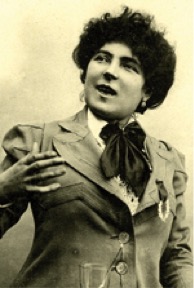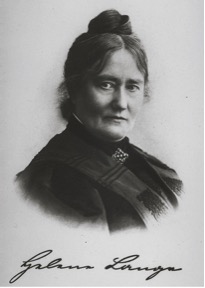Relational Feminism
“Feminist victories are not, strictly speaking, about getting the argument right, nor is gender merely ‘a useful category of analysis’; sexual difference lies at the heart of human thought and politics.” – Historian Karen Offen
The word “feminism” originated in France in the 1870s and was used to define the ideology of women’s emancipation. While individual woman and men and small groups mostly of women demanded more women’s rights since the eighteenth century, the term became more frequently used throughout Europe since the end of the nineteenth century. While today, “feminism” has many varying ideologies, it is defined by Karen Offen, historian of modern Western European women’s history, as“The name given to a comprehensive critical response to the deliberate and systematic subordination of women as a group by men as a group with a given cultural setting.” ”Relational feminism,” which rose to prominence in the late eighteenth century, emphasizes women’s rights specifically as women. It states the differences between men and women provide the reasoning for equality.
Relational feminism, or as it sometimes also is called “maternal feminism,”is often used to describe the dominant thinking in the old women’s movement in Europe prior World War II and the advent of the new women’s movement with its “individual feminism” since the 1960s. Its basic principle, according to Offen, is the assumption that “while men and women are fundamentally different, the distinctive contribution that women make to society, specifically as women, entitle them to equal rights.” Three notable proponents of this approach are the English writer, Mary Wollstonecraft (1759-1797), the French suffragist Jeanne Schmahl (1846-1915) and the German feminist and educator Helene Lange (1848-1930).
Relational feminism relies on the idea that men and women are fundamentally different based on their “nature.” During the late eighteenth century, differences between men and women began to be understood in terms of biology. Natural scientists and philosophers alike used the newly discovered “biological” differences between men and women to argue that they had different but complementary character traits, which in turn led to gender specific roles in the “separate spheres” of men and women in society and culture. Women were thought to be mothers and caretakers in the private sphere of home and the family, while men belonged in the public spheres of business, trade and paid work, politics and war. In this model, women were no longer simply considered inferior to men, like in Christian theology, but different and complementary.
The early feminists used this thinking about the gender order to establish authority and power within the domestic sphere. They believed that women because of their the “maternal” and “nurturing” “gender character”, which they had independent of real motherhood, needed to have much more influence in the economy, society, culture and politics, and were best suited to work in political fields like education, health, welfare etc. Their concept of “spiritual motherhood” allowed relational feminists to campaign for rights based on the “natural” differences of women from men. They campaigned for example for protective labor legislation, demanding a reduction of the working hours of mothers. They also advocated for state sponsored childcare facilities for working mothers and family allowances for all mothers in need.
Since the mid of the nineteenth century European women and women’s groups also began arguing for political equality on the grounds that women’s voices needed to be heard in politics as only they could provide the maternal perspective and spirit that men lacked. This was for example the view of Jeanne Schmahl and Helene Lange, who both thought women’s influence was needed in national affairs in order to make a safe and stable government. Moderate suffrage groups and their campaigns based on relational feminism were established all over Europe at the end of the nineteenth century.
Relational feminism also affected how women perceived their relationships with their husbands. Women argued that they should be respected as wives and mothers. They challenged the notion that men were the masters of women and tried to establish an understanding of men and women as equal partners, each overseeing different spheres of influence. This allowed the activists of the middle and upper-class women’s movements to campaign against issues such as domestic abuse and alcoholism through the temperance movement, which gained considerable mainstream support amongst both men and women. The movement used the assumption that women should control the domestic sphere and that men, by spending their wages on alcohol and getting drunk and often abusive, were corrupting the calm tranquility of the home.
Relational feminism (also called maternal feminism) was the dominant ideology in the European middle- and upper-class women’s movement until the 1950s. Only since the rise of the new women’s movement in the late 1960s critique of this approach to feminism grew. The critics mainly argued that this understanding of feminism restricted the role of women to being mothers and housewives and extended the hierarchical gender division of labor from the private to the public sphere. Their argumentation was informed by “individualist feminism.”This approach to feminism argued since the eighteenth century that women should be seen as equal to men not because of their feminine qualities but as independent moral and intellectual human beings. Individualist feminism was often received unenthusiastically by traditional nineteenth century relational feminists. They s deemed it unfeminine and divisive, because it rejected the importance of the family and the role of the women in it. Two major publications influenced the intellectual formation of individual feminism in Europe: The 1879 book Woman and Socialism(Die Frau und der Sozialismus) by August Bebel (1840-1913) and the 1949 book The Second Sex (Le Deuxième Sexe) by Simone de Beauvoir’s (1908-1986), who famously declared that “One is not born but becomes a woman”.
Despite today’s critiques of relational feminism, it should not be regarded as an philosophy confined to the eighteenth and nineteenth century. Women today often still advocate for rights and legislation based on their role as mothers. Maternity leave, for example, rests on the understanding that women need time off to care for their newborn children. For this reason, historian Karen Offen advocates for a historical understanding of feminism that encompasses both relational and individualistic feminism. While different understandings can be associated with particular time periods, feminism always has incorporated a complex spectrum of ideas.
Likewise, the complexity and diversity of women’s experiences cannot be addressed by one definition or ideology. Women can be understood as both individuals and mothers; children and adults; rich and poor. Feminism and our understanding of it must encompass all aspects of womanhood and work to counter all forms of oppression. Therefore, when examining feminism’s history we must be critical and also take the historical context into consideration. Relational feminism while flawed is still very helpful when understanding the historic struggles of women. We must understand the historical struggles that women have faced in order to better understand the situation of women today.
Katherine Trott, History Major, 2019
Sources
Literature and Websites
- Offen, Karen. “Defining Feminism: A Comparative Historical Approach.” Signs, 14, no. 1 (1988): 119-157.
- Offen, Karen. European Feminisms, 1700-1950: A Political History. California: Stanford University Press. 1999, introduction.
Images



